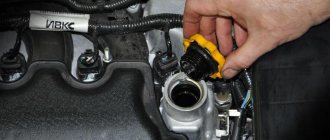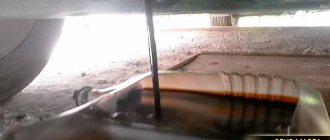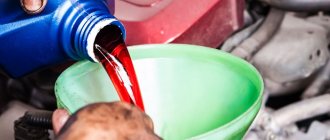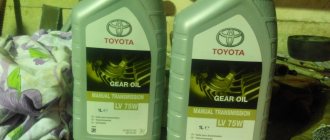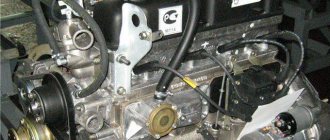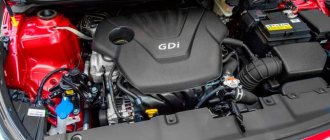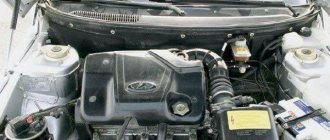Lubrication System - Brief Overview
One of the most important parts of a car engine is the mechanism for lubricating it - the so-called lubrication system. This system is able to effectively protect all internal elements of the machine from wear. To ensure stable and trouble-free operation of the entire engine lubrication mechanism over a long period of time, I advise you to carefully monitor its technological condition throughout all years of operation. Also try to fill it with new lubricant on time or change it to clean one.
In this article, I tried to tell you how you can independently control the amount of oil in the engine lubrication system, and also wrote about the consequences of neglecting this. What can happen if you increase or decrease the amount of lubricant in the lubrication system, I also tried to clearly explain how to correctly change the lubricant in a car engine.
So, let's start by checking the condition and amount of lubricant in the system. Some car owners of recently purchased cars do not understand at all and are not even aware of the consequences of incorrect actions when changing the lubricant. They don’t know how to properly fill the engine with lubricant when driving their car after purchasing it to the first service station.
But why spend money on maintaining your car if you can do everything yourself? At the same time, relying on the warranty from the manufacturer, they quickly forget the main tenets of car maintenance and cease to understand the basic principles of filling oil. They also do not take into account the fact that in the machine operating book all the basic tips for maintaining machine elements are clearly indicated.
By the way, it’s worth checking the lubricant level in the engine from time to time (this must be done once every 12-15 days), especially during long trips.
Important to consider! In order for you to avoid inaccurate information about the amount of lubricant in the engine, you should only check it cold.
To rinse or not?
Do I need to flush the engine when changing the oil? Some, even quite authoritative experts, argue that there is no need to flush the engine. This is justified as follows:
- When performing this procedure, useful additives included in the lubricant are also removed along with the dirt.
- Modern oils are compatible, and even when switching from one type of lubricant to another, nothing bad will happen.
- Flushing dissolves substances deposited in the filter elements, which then end up on engine parts.
To be convinced of the fallacy of these statements, it is enough to examine each of them in more detail:
1. The beneficial substances included in the lubricant form a chemically resistant, durable film on the parts, which washing cannot dissolve. Only those elements that are harmful to engine operation are removed.
2. The compatibility of oils from different manufacturers and even varieties is a myth, a dangerous misconception. Each manufacturer takes its own approach to creating the final product. Some achieve the desired parameters thanks to the high quality of the base oil.
It is impossible to predict in advance how these additives will behave when they react.
Foaming of the lubricant, precipitation of solid or resinous sediment, or simply a decrease in basic characteristics cannot be ruled out. It is possible to avoid the problems listed above when switching from one type of lubricant to another by flushing the engine.
3. Filter elements retain only insoluble particles of a certain size.
Flushing the engine when changing the oil will help you get rid of soluble contaminants. This does not mean that this procedure should be performed every time maintenance is performed. It will be quite enough to flush the engine every second and even third replacement, if you operate your car with the same brand of engine oil.
What to wash with?
How to choose engine flushing oil? Many companies producing automotive lubricants also produce flushes that can be used when replacing. Preference should be given to products from well-known brands and avoid counterfeits of dubious quality. In all cases, the basis of a high-quality mixture is industrial oil with a complex of additives that are safe for oil seals and seals.
How to choose an oil filler cap
The elements of the motor group are operated in particularly difficult conditions and require a properly functioning lubrication system - it prevents the occurrence of dry friction and promotes the removal of excess heat. In addition, this system removes wear products, rust, etc. It will be no secret to any car enthusiast that engine oil needs to be changed regularly. Oil is supplied to the engine through the so-called. oil filler neck with a lid. Although the cover seems to be one of the simplest elements of the car, there is something to be said about it. In this material, Avto.pro will briefly review the operating principle and design of the oil system, its characteristic malfunctions, and will also talk about the method for choosing an oil filler cap.
Service frequency
The frequency of service work on a car engine will directly depend on the type of engine.
Typically, manufacturers advise performing this procedure every 12-15 thousand kilometers. However, in Russian conditions, the fuel is not of the proper quality and contains various additives that enter the lubricant and deteriorate its structure, so it is recommended to change the oil every 2 years or every 8-10 thousand kilometers.
If a car owner neglects the recommendations of the car manufacturer or uses low-quality lubricant, this leads to premature wear, problems with valves and cylinders may appear, and the turbine often fails.
Such an engine will require an expensive overhaul or a complete replacement, so experts do not recommend saving on service by performing this work at a service station or independently using original filters and high-quality consumables.
Design and principle of operation of the lubrication system
The main purpose of the lubrication system of the engine and adjacent components is to reduce friction between the mating elements of the power unit. As already mentioned in the introduction, this system also promotes better engine cooling and removes wear products, carbon deposits, rust and dirt that can enter the system along with the oil. The main elements of the lubrication system are usually:
- Oil pan (metal or plastic) with oil intake;
- Oil filter;
- Pressure meter;
- Oil pump;
- Oil cooling radiator;
- A set of highways and canals;
- Bypass valves.
The oil pan is an oil storage container. There may also be several sensors: oil level and temperature. In the vast majority of cars, the oil level in the crankcase can be monitored using a dipstick. The lubricant is “driven” through the system far from under the influence of gravity. A special pump is responsible for oil circulation, receiving energy directly from the crankshaft or camshaft, and in some car models, from a specially dedicated shaft.
One of the requirements for motor oil is its purity. Because This is a liquid that comes into contact with rubbing and heating parts; it can collect wear products (example: metal shavings), carbon deposits, etc. A special oil filter is responsible for keeping the oil clean. It is recommended to change it simultaneously with replacing the lubricant. The latter, gaining heat from the running engine, is cooled in the radiator. Heat from the radiator is taken away by the flow of antifreeze from the engine cooling system. Bypass valves solve the problem of a possible increase in pressure to dangerous levels. Pressure readings are monitored by a separate sensor.
The lubrication system of the vast majority of modern cars is combined . This means that some of the rubbing parts are lubricated with oil under pressure, while the remaining volume of lubricant splashes or moves by gravity. Moreover, regardless of the design of the system, it will be cyclic, i.e. the oil is pumped in, filtered, “driven through,” cooled, and then the cycle is repeated. In the simplest case, the system works like this:
- When the engine starts, the oil pump comes into operation. An important point: a thin oil film already covers some of the rubbing parts, so the risk of dry friction is minimal, but it is still worth warming up the lubricant at idle;
- Oil from the sump moves through the oil filter, the main oil line and gets to the connecting rod and main bearings, as well as the camshaft cams and bearings;
- From the front main bearing, the oil moves to the timing drive and cylinder head, forming an oil bath that lubricates the rocker arms, valves, pushers and other engine elements;
- At the same time, oil enters the connecting rod channels, and in some systems it is sprayed with special oil nozzles;
- Oil droplets form the so-called. oil mist near some moving parts, but most of it flows back into the crankcase.
BAS012 › Blog › CHANGING ENGINE OIL. ADVIСE
In this article we will tell you how to change the engine oil, what is the oil change interval, and also which filters need to be changed when changing the oil.
HOW TO CHANGE THE ENGINE OIL?
Changing the engine oil of different brands of cars is not very different and follows the same pattern. To begin with, select a motor oil that is suitable for the type and brand of engine.
The procedure for changing engine oil is as follows:
tips for changing engine oil To drain the oil, you need to unscrew the plug on the engine crankcase. This is usually the lowest point on the pallet, or check your owner's manual to be sure. To begin with, unscrew the crankcase plug with a wrench, and finally with your hands, because the oil will flow out immediately and quickly (place a container for draining in advance), because the plug can be lost.
The oil is drained from the engine quickly, usually no more than five minutes. But it is not possible to drain the oil from the engine one hundred percent. It's not scary, because... Usually no more than 2-3% of the old oil remains in the engine.
The old oil is drained, the color and the presence of foreign impurities are assessed. These factors determine whether an engine flush is required or an oil change without flushing is necessary. Afterwards, new oil is poured in, the oil filter is changed and the oil change is considered complete.
When pouring oil into the engine, constantly monitor the level using the dipstick. You need to fill according to the level, between o and “max”. Fill in 80% of the total volume and then constantly top up, adjusting with the dipstick.
ENGINE OIL CHANGE INTERVAL
How often do you change the engine oil and should you follow the manufacturer's recommendations? For modern engines, when the quality of oils improves, it is recommended to replace them after 10-15 thousand kilometers. It should be borne in mind that this value is determined by the manufacturer under normal operating conditions. The worse the operating conditions, the more you should think about changing the engine oil early.
What is considered difficult conditions? This should include climatic conditions: frost, frequent temperature changes, humid climate, high dust content in the air. Frequent engine overloads (for example, in mountainous areas or when transporting heavy loads) also do not help maintain the performance of the oil. Typically, if operating conditions are determined to be severe, it is recommended to reduce the mileage before an oil change by 25-30 percent.
Operating a car in the city is equated to being particularly difficult - a sluggishly flowing plug kills oil as actively as dirty off-road conditions. Average oil change times: 5,000 - 7,000 km for mineral water and 10,000 - 12,000 km for synthetics.
DO I NEED TO CHANGE THE OIL FILTER WHEN CHANGING THE OIL?
When changing engine oil, be sure to replace the oil filter. If you change the oil at a car service center, the service includes replacing the oil filter. So why change the oil filter?
Operating an engine with a clogged oil filter is equivalent to operating without it, because... the oil is bypassed past the filter element. This is provided for by the design of the oil filter. When changing the oil, it is necessary to change the filter, because during normal operation it will be clogged by 10,000 km, which will lead to the opening of the bypass valve and the oil will go to the rubbing vapors uncleaned. This results in intense engine wear. Although the emergency pressure light will not light up.
If you change the oil filter yourself, do not forget to fill it with engine oil to about half the volume (for a better first start after changing the oil) and lubricate the rubber on the filter housing.
TIPS FOR CHANGING ENGINE OIL
1. Choose your engine oil carefully. Buy those that meet the vehicle manufacturer's tolerances and approvals. Remember that viscosity is not the most important parameter.
2. Do not abuse “express” oil changes. The disadvantage of vacuum oil changes is that much more used motor oil remains in the engine than with a traditional oil change using the drain method. Therefore, this method must be alternated with traditional draining, while reducing the service interval.
3. Change your oil more often! No air filter will capture all the dust and dirt that is present in the air. And, accordingly, not a single fuel filter will retain impurities that are sold at gas stations along with fuel as a free bonus.
5. Monitor the oil level using the marks on the dipstick. Not adding enough oil to the bottom mark can lead to oil starvation of the rubbing parts, which will lead to their rapid wear. Overfilling the oil also negatively affects the operation of rubbing parts.
6. Do not buy motor oils from dubious sellers! A 100% counterfeit motor oil will not meet the requirements of the car manufacturer, so the engine can quickly fail. Buy original oil at branded gas stations or find the nearest store that sells original products. Metal cans also serve as protection against counterfeiting.
Source
Reasons for increasing oil thickness levels
Usually this is the penetration of any soft objects or third-party liquids into the car crankcase (antifreeze or automobile fuel may well get into the crankcase). By the way, when the internal gaskets wear out or when cracks appear, the technical mixtures in the engine are changed while driving. As a result, noticeable symptoms of engine failure may appear (blue or sulfurous smoke billows from under the hood).
To avoid any problems when driving a car, it is recommended to find out in advance how to fill the lubricant or replace the lubricant in the engine.
Why change it?
Generally speaking, motor oil is a patient product. And if you create heavenly conditions for it - a clean, brand new engine, medium speeds, low loads (read: operation without overheating), then it will last longer than smart books say. But heaven is where we are not. In real life, oil begins to age literally from the moment it moves from a sealed canister into the labyrinths of the engine. Its oxidation begins, accelerated by constant heating and cooling, detergent additives leave, and dirt accumulates. There is nothing unexpected in all this: the oil must not only lubricate and cool, but also wash the engine, and also remove various impurities from it. But it is quite obvious that the rate of aging of motor oil greatly depends on its operating conditions.
Stage one - preparatory
We drive the car out of the garage, warm up the engine, to do this we let the car idle for ten minutes. This is necessary so that the oil heats up and flows out of the engine easily. Cold oil will be more viscous, will flow slowly, and a lot of old oil will remain on the walls of the engine crankcase. While the car is warming up, we build an overpass from two pieces of wooden beams 150x150x400 and two boards 50x150x1200, as shown in the photo.
We drive slowly and carefully along the boards to the top of our overpass.
How is it determined how much oil is in the engine?
Any car owner has the opportunity to find out for himself how much oil to fill his car and where to fill the engine oil. Typically, the required amount of motor lubricant is prescribed in the owner's manual for the car.
The amount of oil is set with the engine turned off, either ten minutes after it is completely turned off, or before starting. To ensure correct measurements, the car must be on a horizontal, smooth surface.
Included with any car is a special dipstick for measuring car oil. It is usually located in the front area of the motor and looks like a thin metal strip with marks on it.
In order to get the dipstick, you need to grab the ring handle and pull it in your direction. Wipe it free of liquid, immerse it completely in the motor and lift it up again.
The volume of motor oil is set by divisions. If the lubricant has reached the upper mark, there is no need to add oil to the engine. If the fluid level approaches the lower mark, you need to fill the engine with oil.
Drain the used oil
Drive the car onto a lift or inspection hole; if you have neither one nor the other, then in this case you can make an overpass with your own hands.
To do this, you can use boards, cinder blocks and bricks. Just be extremely careful, you need to create a reliable platform.
Let’s say that if you change the oil in a Vesta engine yourself, then in this case we can immediately get to the drain plug.
And on some models you can only get there when the protection is completely dismantled. Then the neck needs to be unscrewed, this is done using insert keys, they are called “torxes”.
But if you consider changing the oil in the Kalina engine with your own hands, then you need a wrench to unscrew the neck.
Unscrew the filler plug, this will eliminate the effect of vacuum and the flow of oil will significantly accelerate. Then we substitute the container and unscrew the drain plug, leave the engine in this state for 15 minutes to completely drain the oil.
“My car will tell you when to add oil.”
We are accustomed to the fact that all cars have indicators on the instrument panel with a picture of an oil can or the inscription OIL. Many drivers do not bother checking the oil level, hoping for help from the on-board diagnostic system. But this is not always justified. The fact is that that same indicator indicates a problem with the oil pressure, and not its level. In simple terms, the oil pump takes oil almost from the very bottom of the pan. Accordingly, as long as it exists in principle, there will be no problems with pressure in normal modes. They can occur during sudden maneuvers, driving uphill or downhill, and only then air will enter the pump and the light will come on. So it is wrong to rely on a familiar indicator in terms of level control.
To change the lubricant in a car, you should do the following:
- Place your car with a warm engine in a garage pit or on an overpass, if you have one. Next, simply open the hood and remove the neck from the engine drain hole.
- At the same time, place an empty container under this neck, then manually unscrew the drain cap.
- When everything goes out, carefully pour new clean oil into it and turn on the engine. Also, don’t forget to fill the engine with oil through the filler neck. What to do next? Just turn the cap and screw it back to its original position - back.
- At the end of the procedure, all you have to do is turn on your car and check that the pressure level warning light has stopped lighting.
- I also hope it will not be a discovery for you if the lamp does not light up when you turn on the engine for the first time. Typically, the system needs about 20 seconds for the motor to develop the pressure necessary for its operation.
Do you already know when to change the oil in your car's gearbox?
Tell me, when you were looking for information on the request “changing transmission oil”, did you come across the statement that it is not necessary to change it at all? There are a lot of misconceptions on the Internet about checkpoint maintenance that are far from the truth. Practice shows that any lubricants lose their properties over time (oxidize, additives are depleted, fumes appear) and need to be replaced.
So, when does the moment come when you need to buy and change the fluid in the box?
First you need to decide on the type of checkpoint:
- automatic (automatic transmission);
mechanical or manual (manual transmission);
dispensing room (RK).
The manual, or technical manual for your car model, contains information about gearbox lubricants. It indicates after what period of time or mileage to replace it, how many liters of oil are in the box, and what kind of transmission oil to fill.
Often, box manufacturers recommend changing the lubricant every 60-90 thousand. km, and in difficult operating conditions - 2 times more often. Also, the oil volume in the gearbox differs, which can range from 1.2 liters to 15.5 liters, depending on the type of gearbox itself.
Do you have additional questions about how and when should the oil be changed in a transfer case, automatic transmission or manual transmission? Then contact our experts by phone and get practical recommendations on working with lubricants.
Why do you need to change the engine oil?
What role does oil play in the power unit, is it important to replace the lubricant, when is this procedure required, work regulations - every vehicle owner should, at least superficially, understand this issue.
When the motor operates, various components and mechanisms move and come into contact with each other. Friction causes increased wear of parts.
Motor oil creates a film on their surface that prevents dry friction. In addition, lubricant helps remove heat from rubbing mechanisms, remove wear products and protect components from corrosion.
All technical fluids, including engine oil, are consumables. Over time, they lose their original properties. To maintain performance and increase the life of the power unit, the lubricant must be changed periodically. Why is it important to do this in a timely manner?
Thus, one conclusion can be drawn - failure to replace the lubricant on time can lead to premature failure of the power unit. Major engine repairs are fraught with serious material costs.
Engine oil wear is more difficult to visually determine than, for example, pads or tires. Therefore, you should follow the recommendations of the vehicle manufacturer.
During warranty service, the dealer monitors the schedule of service work; the owner of the equipment is only required to provide the iron horse for maintenance in a timely manner. Otherwise, it may be void of warranty.
After the end of the warranty period, the car owner needs to be more careful (if he refuses the services of a dealer service station) and carry out maintenance, adhering to the recommendations specified in the service book.
When to add oil to the engine?
The question is rather rhetorical. Of course, immediately after detecting a low level. As a rule, the car owner knows what the car's lubricant consumption is. By regularly looking at the odometer, you can accurately determine the need to replenish the volume. At the same time, no one canceled regular monitoring.
If there are 1000-1500 km left before the next scheduled maintenance, there is no point in wasting fresh engine oil on topping up. Perform maintenance ahead of schedule. At the same time, you should purchase new oil with a reserve, since you know exactly how much fluid will have to be added during the service period.
Where to pour oil into the engine
The most frequently asked questions are how to add oil to the engine, the top-up interval and where to add engine oil. Knowing a little about the design features of power units, you can immediately guess that filling and topping up engine lubricant is carried out through the filler neck located on the cylinder head cover.
As you know, during the operation of the power unit, the oil gradually disappears. There can be various reasons for this: leaks, grease combustion, and others. The average recommended engine lubricant consumption is 100-200 grams for every 1000 km. This indicator may vary depending on the design features of the engine.
How to add oil to the engine correctly. Part 3
Author Sergey Bukhransky
Updated: 06/30/2019 21:53 Published: 05/20/2019 09:21
Auto
We continue the article about the intricacies and features of correct oil addition. It turns out that many people do not know certain rules, which leads to early engine wear. Therefore, we will try to cover this topic completely.
7 shared
Where should I add oil?
On the one hand, many will smile, because almost everyone knows where the valve cover is located on the car, where the missing oil should be poured. But it's not that simple. Indeed, in most cars the valve cover catches the eye immediately after opening the hood, but many new cars have maintenance-free engines, and in order to get to the neck of the valve cover you need to remove the plastic engine protection and look for the neck exactly under it. But it should be noted that most often the valve cover is located on this plastic protection.
How to top up, on a hot or cold engine?
We must immediately put an end to this dispute; any procedure for adding oil to the engine should be carried out only on a cold engine. All disputes on this topic must be stopped; pouring oil into a hot engine is prohibited. You must immediately remember that if you pour cold oil into a hot engine, this can lead to serious malfunctions. As a result of a sharp change in temperature, cracks may appear on some engine parts and the geometry of the engine may generally change. Therefore, in any situation, you should wait until the engine cools down and only then add oil to it.
You also need to remember that the correct oil level can be determined with a dipstick only on a cold engine, when all the oil has drained into the pan. You should also check the actual oil level at least once a week in order to renew it in a timely manner if necessary.
When and how much oil to add is decided by the driver himself. It all depends on the engine itself. The most correct level would be in the middle, between the minimum and maximum. Moreover, it is not advisable to overflow. Sometimes car owners believe that the more oil, the better. However, this is wrong. Excess oil leads to increased pressure and can lead to serious engine damage.
Can I add oil myself?
Sometimes motorists are afraid to carry out such work themselves. But this is exactly the case when even a fragile girl can cope with it. It is important to remember some of the rules mentioned above. Oil must be poured into a cold engine and adhere to the middle mark on the dipstick. If the oil level on the dipstick is seriously reduced, then you should pour oil in portions. That is, you can immediately splash five hundred grams, then wait ten minutes and check. If the level is lowered again, then you can add another five hundred grams.
Photo: proavtomaslo.ru
Don't forget to subscribe to the Auto Column channel in Yandex.Zen. We intend to continue telling our readers something that will surprise you...
Normal oil pressure in a car engine
One of the most common questions along with choosing engine oil is determining its pressure level in the engine.
As a rule, many modern car models do not have special devices that display pressure data on the dashboard - only an emergency warning signal is provided in the form of a light bulb.
It is almost impossible to independently monitor pressure changes without directly checking the engine.
Choosing a high-quality lubricant is not the whole process of preparing a car for the new season
It is important to know what oil pressure should be in the engine in order to ensure its smooth operation. This indicator largely depends on the engine itself: the number of horsepower, cylinders and valves, the type of fuel used
For idle speed, the average norm is about 2 bar, for high speed – from 4.5 to 6.5 bar. However, such information is included in each operating manual and technical documentation for the car.
Is it possible to fill in engine oil “with a reserve”?
No, you can't do that. If you know for sure that the engine “eats” oil, and there is a danger of ending up in the middle of the highway with a critically low level, fill the fluid up to the “MAX” mark (not higher!), and check the level as often as possible. Always keep a liter canister of reserve in the trunk.
How to properly add oil to the engine - video In any case, if engine oil consumption is critically high, it is necessary to identify the cause and put the engine in order.
Replacement Regulations
Even the most experienced auto mechanic will not tell you the exact numbers, and the reason is that the replacement period depends on many factors. Because different parts are used, machines are operated differently, different types of oil are poured, and other factors.
The approximate replacement periods have already been established, for example, if you fill in synthetic oil, then you need to change it every 12 thousand kilometers.
Mineral oil loses its main qualities much faster, so it will have to be drained after 6-7 thousand kilometers. And if you use semi-synthetics, then in this case you need to change the oil after about 10 thousand kilometers.
Severe operating conditions also have a significant impact on the replacement period. If the car is used in such conditions, then you will need to change the oil in the Chevrolet engine yourself much more often.
Severe conditions are considered:
- Terrain (hills, mountains, sharp ascents and descents).
- Sporty driving style.
- Strong changes in ambient temperature.
- Constant traffic jams.
- Required materials and tools
- New filter (buy the one recommended by your car manufacturer).
- Serrated wrench.
- A set of keys.
- New engine oil (recommended by the manufacturer).


